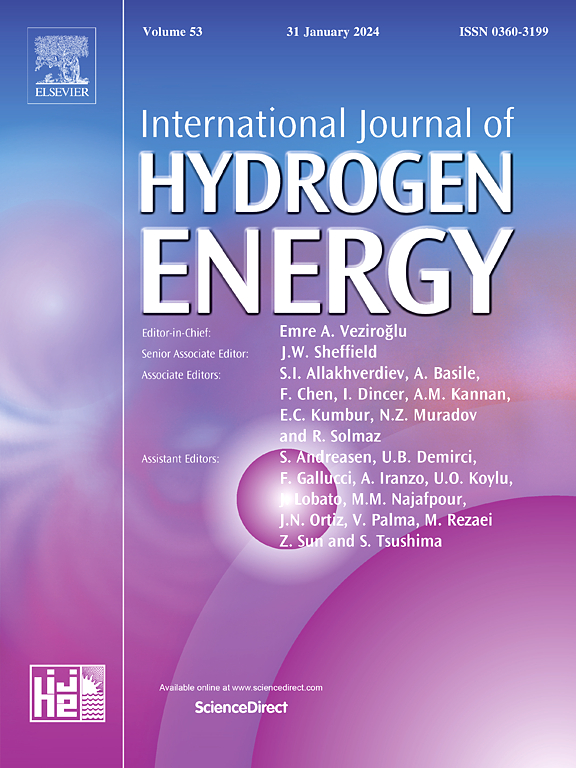Ultrahigh hydrogen storage capacity of B3O3 monolayer with electric-field-controlled reversible dehydrogenation
IF 8.1
2区 工程技术
Q1 CHEMISTRY, PHYSICAL
引用次数: 0
Abstract
State-of-the-art density functional theory (DFT) calculations were employed to investigate the potential of the newly synthesized porous B3O3 monolayer (ML) for hydrogen storage applications. While pristine B3O3 ML exhibits weak hydrogen adsorption ( eV per H2 molecule), its decoration with lithium (Li) or sodium (Na) can significantly enhance the average adsorption energy ( eV per H2 molecule). The pore of B3O3 has more capacity towards Li doping, with the ability to accommodate up to six Li atoms, each capable of attracting more than three H2 molecules, compared to a maximum of only two Na atoms. Ab-initio molecular dynamics (AIMD) simulations confirm the thermodynamic stability of both 6Li@B3O3 and 2Na@B3O3 MLs at room temperature (RT 300 K). Thermodynamic analysis, based on Langmuir model, showed that the 6Li@B3O3 primitive cell can store approximately 19.26 H2 molecules, yielding a high effective gravimetric capacity ( 16.09 wt% at RT), whereas 2Na@ B3O3 can store about 11.58 H2 molecules only ( 10.07 wt% at RT). Both values are significantly higher than the U.S. Department of Energy's 2025 target of 5.5 wt%. Furthermore, charge transfer analysis based on the Bader method and charge density difference (CDD) has confirmed charge transfer from Li/Na atoms to H2 molecules, confirming the role of H2 as charge acceptors. The application of electric fields oriented away from the surface can reduce the adsorption energy, thereby facilitating H2 desorption. Based on these characteristics, Li- and Na-decorated B3O3 ML stand out as promising candidate materials for hydrogen storage applications.

电场控制可逆脱氢的B3O3单层超高储氢容量
采用最先进的密度泛函理论(DFT)计算研究了新合成的多孔B3O3单层(ML)在储氢方面的应用潜力。原始b3o3ml对氢的吸附能力较弱(Eads = 0.12 eV / H2分子),而用锂(Li)或钠(Na)修饰可以显著提高其平均吸附能(Eads = 0.32 eV / H2分子)。B3O3的孔对Li掺杂具有更大的容量,能够容纳多达6个Li原子,每个Li原子能够吸引3个以上的H2分子,而最多只能吸引两个Na原子。Ab-initio分子动力学(AIMD)模拟证实了6Li@B3O3和2Na@B3O3 MLs在室温(RT ~ 300 K)下的热力学稳定性。基于Langmuir模型的热力学分析表明,6Li@B3O3原始电池可以存储约19.26个H2分子,在RT下产生高的有效重量容量(Ceff = 16.09 wt%),而2Na@ B3O3只能存储约11.58个H2分子(Ceff = 10.07 wt%)。这两个数值都明显高于美国能源部2025年5.5%的目标。此外,基于Bader方法和电荷密度差(CDD)的电荷转移分析证实了电荷从Li/Na原子转移到H2分子,证实了H2作为电荷受体的作用。施加远离表面的电场可以降低吸附能,从而有利于H2的解吸。基于这些特性,Li和na修饰的b3o3ml作为储氢应用的候选材料脱颖而出。
本文章由计算机程序翻译,如有差异,请以英文原文为准。
求助全文
约1分钟内获得全文
求助全文
来源期刊

International Journal of Hydrogen Energy
工程技术-环境科学
CiteScore
13.50
自引率
25.00%
发文量
3502
审稿时长
60 days
期刊介绍:
The objective of the International Journal of Hydrogen Energy is to facilitate the exchange of new ideas, technological advancements, and research findings in the field of Hydrogen Energy among scientists and engineers worldwide. This journal showcases original research, both analytical and experimental, covering various aspects of Hydrogen Energy. These include production, storage, transmission, utilization, enabling technologies, environmental impact, economic considerations, and global perspectives on hydrogen and its carriers such as NH3, CH4, alcohols, etc.
The utilization aspect encompasses various methods such as thermochemical (combustion), photochemical, electrochemical (fuel cells), and nuclear conversion of hydrogen, hydrogen isotopes, and hydrogen carriers into thermal, mechanical, and electrical energies. The applications of these energies can be found in transportation (including aerospace), industrial, commercial, and residential sectors.
 求助内容:
求助内容: 应助结果提醒方式:
应助结果提醒方式:


